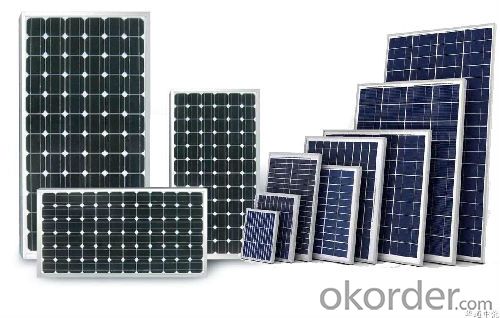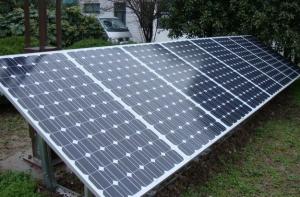LDK 60-cell MULTI MODULE 255W Low price and High Efficiency CE TUV Certification
- Loading Port:
- China Main Port
- Payment Terms:
- TT or LC
- Min Order Qty:
- -
- Supply Capability:
- -
OKorder Service Pledge
OKorder Financial Service
You Might Also Like



Dimensions(Laminate):1636 x 986 x 35 mm[64.41 x 38.82 x 1.38 in]
Solar Cells:60 (6x10) multicrystalline silicon -
156 x 156 mm [6 inch] solar cells
Why US?
· Industry leading module power output warranty of 25 years
· International quality and safety certifications
· Manufactured in ISO 9000 certified factories
· High-reliability with guaranteed 0/+5W peak power classification
· Excellent performance under low light environments
· Entire module certified to withstand high wind and snow loads
Warranty
· 10 years for product defects in materials and workmanship
· First 12 years for 90% of warranted minimum power
· Remaining 25 years for 80% of warranted minimum power
Vertically integrating business model enables us to
· Consistently build high quality and reliable PV products.
· Optimize our cost structure to deliver price-competitive products.
· Adopt cutting-edge product and production technologies.
· Develop the most advanced manufacturing methods.
· Minimize carbon emissions throughout our closed loop production process.
Certification
· IEC:IEC 61215, IEC 61730 (1&2), conformity to CE
· UL 1703 2002/03/15 Ed:3 Rev:2004/06/30
· ULC/ORD-C1703-01 Second Edition 2001/01/01
· UL and Canadian Standard for Safety Flat-Plate
· ISO 9001: 2008 Quality Management Systems
· CEC Listed: Modules are eligible for California Rebates
· PV Cycle: Voluntary module take back and recycling program
· MCS Certificate
After-sales Services Undertakings
1. During the equipment commissioning period, the company will send scheduler to commissioning to ensure debugging smoothly and a one-time test commissioning.
2. The company is responsible for professional users’ on-site operator training and technical exchange.
3. The long-term tracking service system: we practice lifelong quality of our product tracking service, and we also will take effective measures and solutions for the user of the technical issues and equipment problems.
4. Regularly listen to opinions and suggestions of users, to provide users with new trends in technological innovation, new product information and enhance mutual understanding.
5. Any problems, the company will provide solutions for users within 48 hours.
FAQ
Where can I buy your products?
You could find our products from dealers or contact our sales team directly. We will provide you with detailed services.
How to contact us?
Contact details can be found from website www.okorder.com to contact us. We look forward to providing you with professional services.
What is the application field of your products?
They can be used in the small photovoltaic (PV) grid power generation systems of family units as well as the commercial photovoltaic system such as BIPV, BAPV and etc.
What kinds of modules do your inventers support?
Our inventers support most of mainstream components and modules in the market. Should you require more details, please do not hesitate to contact our technical personnel.





- Q:Can solar panels be installed on agricultural irrigation systems?
- Yes, solar panels can be installed on agricultural irrigation systems. They can provide a sustainable and efficient source of energy to power the irrigation system, reducing reliance on traditional electricity sources and reducing operational costs for farmers. Additionally, solar panels can help farmers become more environmentally friendly by reducing carbon emissions associated with irrigation.
- Q:How do solar panels affect the aesthetics of a roof?
- Solar panels can have both positive and negative effects on the aesthetics of a roof. On one hand, they can enhance the visual appeal by giving the roof a modern and eco-friendly look. On the other hand, some people may find the appearance of solar panels less attractive or disruptive to the overall design of their roof. Ultimately, the impact on aesthetics largely depends on personal preferences and the design integration of the solar panels into the roof.
- Q:I have four power packs for solar lights. They have 3 AA .2volt batteries of 2450 mAh capacity installed in series for a total supply voltage of 4 volt maximum for the lights. I want to charge all four packs at once off a single 6 volt solar panel. With the four packs wired in parallel, what capacity output (wattage) panel do I need to charge the batteries in an 8 hour day?
- Each battery pack has the equivalent of only 2450mAh capacity at 4 volts, so for 4 battery packs like that, a total capacity of 9800mAh. Assuming that the solar batteries have no charge left after being on all night, and that day charging time equals night discharging time, the theoretical wattage would be 9800mA times 6 volts = 59 watts. Of course, battery charging is not 00% efficient, so you need more wattage than that. Plus, solar panels are rated at peak output at midday, while at other times of day their output is less than rated. And, the charging in parallel isn't a good idea, because real batteries have different internal resistances, some batteries would become overcharged, while other packs wouldn't get the charge they need.
- Q:I'm trying to charge rechargeable AA batteries with a solar panel. What guage wire should I use to connect the panel to the batteries? Should I use a diode to keep the batteries from overpowering the circuit? If so, what size? My panel is 4.8V 50mA.
- With that size panel, you should be able to recharge either AA battery, or two AA batteries in series. Yes, it would be a good idea to put a blocking diode in series with the panel - anything will do, like a N448. You will want to use NiCd batteries if possible, because they take a trickle charge of 50 mA much better than NiMH (which prefers pulse charging, a more complicated circuit). You can use NiMH if you must. Needless to say, don't try to charge non-rechargable batteries. Also realize that at this charge rate, it will take days, maybe even a week, to charge the batteries, if left out in full sun all day long.
- Q:Are there any noise concerns with solar panels?
- No, there are no noise concerns with solar panels. Solar panels produce electricity by converting sunlight into energy and do not generate any noise during their operation.
- Q:Can solar panels be installed on museums or cultural centers?
- Yes, solar panels can be installed on museums or cultural centers. In fact, solar panels are a popular choice for these buildings as they not only provide a sustainable source of energy but also promote environmental consciousness and serve as an educational tool for visitors. Additionally, solar panels can help museums and cultural centers reduce their energy costs and contribute to a greener future.
- Q:Do LED lamps ever go bad?What's the life expectancy of solar panels?
- LEDs last approximately 50,000 hours of operation, continuous or non-continuous, it doesn't matter. 50,000 hours. Solar panels will, theoretically, last until the end of time. The support structures will fail long before the panels themselves. Inverters, battery banks, op-amps, transformers, control boards, etc. will all fail long before a solar panel stops making juice.
- Q:What are the benefits of solar panel heating?What does it cost for solar panels?any other important facts about it?
- Solar okorder /
- Q:For those solar panels that you install on your rooftops, do they generate electricity when it's cloudy? And if yes, how much electricity does it generate compared to sunny days? For example...like only 25% electricity generated compared to sunny days?
- Yes. If there is any light, even on a cloudy day, a solar panel can generate power. But the amount of power generated is much less when the solar panel is not in direct sunlight (about 90% less). On a cloudy day, typical solar panels can produce 0-25% of their rated capacity. The exact amount will vary depending on the density of the clouds, and may also vary by the type of solar panel; some kinds of panels are better at receiving diffuse light. SunPower solar cells, for example, have been designed to capture a broader range of the solar spectrum. By capturing more red and blue wavelengths, their solar panels can generate more electricity even when it’s overcast. Ultraviolet light also reaches the earth’s surface in abundance during cloudy days (if you’ve ever been at the beach when it’s cloudy and gotten a sunburn, you’ve experienced this firsthand). Some solar cells are in development that can capture UV rays, although these are not out on the market yet. Even with a standard solar panel on a cloudy day, though, you will be able to generate some power when it’s daylight. The same thing is true in foggy weather. If you live in a city with frequent fog, like San Francisco, you’ll still be able to generate electricity when the fog rolls in. :)
- Q:Can solar panels be installed on schools or universities?
- Yes, solar panels can definitely be installed on schools or universities. In fact, many educational institutions are increasingly adopting solar energy as a sustainable and cost-effective solution to meet their electricity needs. By installing solar panels, schools and universities can reduce their carbon footprint, save money on energy bills, and provide a valuable educational opportunity for students to learn about renewable energy.
1. Manufacturer Overview |
|
|---|---|
| Location | |
| Year Established | |
| Annual Output Value | |
| Main Markets | |
| Company Certifications | |
2. Manufacturer Certificates |
|
|---|---|
| a) Certification Name | |
| Range | |
| Reference | |
| Validity Period | |
3. Manufacturer Capability |
|
|---|---|
| a)Trade Capacity | |
| Nearest Port | |
| Export Percentage | |
| No.of Employees in Trade Department | |
| Language Spoken: | |
| b)Factory Information | |
| Factory Size: | |
| No. of Production Lines | |
| Contract Manufacturing | |
| Product Price Range | |
Send your message to us
LDK 60-cell MULTI MODULE 255W Low price and High Efficiency CE TUV Certification
- Loading Port:
- China Main Port
- Payment Terms:
- TT or LC
- Min Order Qty:
- -
- Supply Capability:
- -
OKorder Service Pledge
OKorder Financial Service
Similar products
New products
Hot products
Related keywords

































